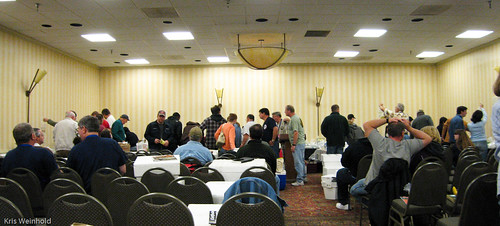Catfish Convention Auction
October 19th, 2008After an extremely busy couple of days preparing for and attending a family wedding, I managed to carve out some time to attend the All-Aquarium Catfish Convention auction. I was very pleased to be able to catch up with Dr. Devon Graham, who runs and operates Margarita Tours, which is the company I traveled to the Peruvian Amazon with in August 2007. In addition, from everyone I talked to, it sounds like the convention itself was a tremendous success. I’m very proud of GWAPA participating on Friday night with a workshop about planted-tank-friendly catfish, and representing with a beautiful informational display table. That was all made possible by the work of some very dedicated members.

The auction was huge, consisting of 10 lots of items. I brought 15 bags of plants and fish, and I suspect everyone else did similarly because there could be no less than 1000 items there. Plants, catfish, killies, cichlids, tanks, tools, equipment, it was all present. My only buy of the day was a fantastic grab, pulling 20 Bristlenosed Pleco juveniles for only $14. I have no idea what I’m going to do with all of those if they reach adulthood, but I’ll enjoy raising them up, possibly breeding them, and passing them onto other aquarists. I’d love to hear what everyone else in attendance came away with.















 Today was the first day of the
Today was the first day of the  a large local aquarium club. The program director is Andrew Blumhagen (left), who opened the convention by introducing to us hobbiest, and corydora expert, Ian Fuller (right), all the way from Great Britain.
a large local aquarium club. The program director is Andrew Blumhagen (left), who opened the convention by introducing to us hobbiest, and corydora expert, Ian Fuller (right), all the way from Great Britain.
 The second speaker at the convention was Lee Finley, who gave a presentation focusing solely on how to feed your catfish the kind of food they would normally eat in the wild. Basically, catfish don’t just eat algae and detritus when in the wild. Depending on the species, they’ll eat wood, bark, algae,
The second speaker at the convention was Lee Finley, who gave a presentation focusing solely on how to feed your catfish the kind of food they would normally eat in the wild. Basically, catfish don’t just eat algae and detritus when in the wild. Depending on the species, they’ll eat wood, bark, algae, detritus, veggie matter, fish, insects, larvae, worms, the list goes on. His slide of the commonly known Vampire Pleco, or Rabbit Tooth Pleco, illustrated how specialized some of these catfish have become. These Plecos used their “two front teeth” to chisel away at wood, searching for inserts; much like a
detritus, veggie matter, fish, insects, larvae, worms, the list goes on. His slide of the commonly known Vampire Pleco, or Rabbit Tooth Pleco, illustrated how specialized some of these catfish have become. These Plecos used their “two front teeth” to chisel away at wood, searching for inserts; much like a  wood pecker would do in a forest. Unfortunately, Lee had to rush through his talk in order for everyone to make it to the much anticipated Italian dinner.
wood pecker would do in a forest. Unfortunately, Lee had to rush through his talk in order for everyone to make it to the much anticipated Italian dinner.